Norman Legal History
Stephen
Earliest judicial writs emanate from this reign.
Van Caenegem, writs no 45 Regesta iii 692
Henry I
statutum decretum keeping traditional customs meant that women could inherit and divide the land even though military tenure was developing to the advantage of the male heir
Evernote - Visibility of Trannsactions & p171
Chibnall - court "repository of custom"
Leges Henrici Primi
Writ of 1108 issued by HII made it plain that land pleas between king's tenants in chief be heard in King's court. Those between vassals of different lords in county court and those between vassals of same lord in that lord's court.
Parage see first para p174. Lead to primogeniture rule
Writs show serious problems with military tenants who refused to render service to their abbots and from farmers who still believed they could pass on their family estates to their heirs
Established national finance, Pipe Rolls
Grant Concerning Scrutage 1127. Scrutage effectively Royal tax
William II
Writ for Collection of Relief. No opportunity to refuse.
Penalty is forfeiture of land
William I
Compurgation or wager of law. Alternative was battle or ordeal. Justice administered by travelling magnates
Seperated secular and temporal courts
Established "pure" feudal system
Subinfeudation
Intrinsec arises from agreement between 2 persons/Forinsec e.g. obligation to king
Bookland - appears to have been
based on kin rather than lordship. See p164 Chibnall
Laws and customs saved by ecclesiastical
scribes and used by Norman Administrators esp.
Worcester and Rochester. Nothing later than
Cnut appears to have been relied upon.
Concerned mostly with criminal matters
and adapted provisions from earlier codes
Did not deal with inheritance but
only unlawful occupation of property
Did not deal with non-criminal matters
Local communities had more
effective share of maintenancxe of
law & order than the Normans had
System in place of
kinship and lordship
but Normans were to develop
Lordship. This was to influence
descent of property through
lines and also methods of law
enforcement/peace keeping
Inherited working system which needed subjugation
Norman customs and laws
Alod. System whereby land held by hereditary
right and did not imply full possession
Lordship powerful but feudal tenures slow
to emerge as patrimony strong
Writs
Vernacular Writs
recorded grants of land or
rights given by King to Beneficiary
Most disposals/transfers done by
witnesses. Also use of writ charters
andlandbooks but not common
Property divided into
acquisitions and patrimony
Courts
Shire
Heard claims for property
Hundred
Breach of peace
Sac & Soc - the full right of administering
justice in a manor or lordship.
Honorial
Ecclesiastical courts heard many
cases beyond their strict jurisdiction
No clear concepts of abstract law
such as property or freedom
Glanvill
tried to formulate some general rules. If, for eg, a knight or tenant of a military fee died the oldest son would inherit. If no sone daughters inherit equally. Glanvill vii. 3 p76
Had "smattering of Roman law" which misled later historians
Henry II
HII's judges insisted on written evidence of land holding
Kings justice
Moved Sherrif's office from barons to lawyers/soldiers
Some had already made position hereditary
Assize of Arms 1181. Fryd resurrected meaning that HII could dispense with baronial military service. Trusted the people more than the barons. p24 intro Stubbs? earlyenglishlaws.ac.uk
Assize of Clarendon. 1166 An attempt to
retrieve power from the local magnates
and return it to the crown
Laws issued "cum consenso et consilio"
Introduced jury who were at first
witnesses of fact. In other words they knew the
defendant/claimant etc
No real attempt to introduce
integrating laws instead use made of existing customs and laws

